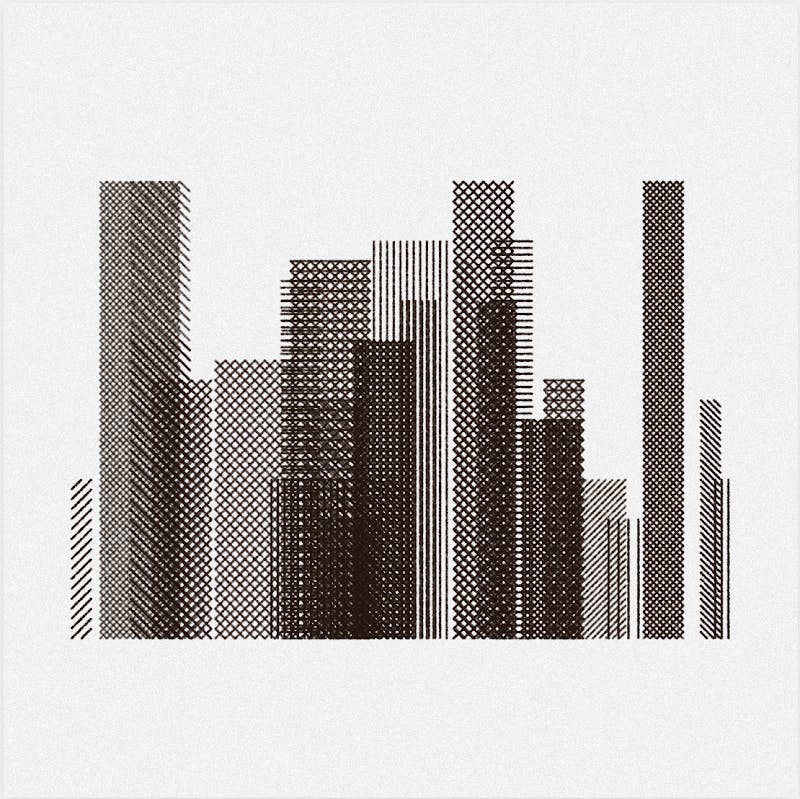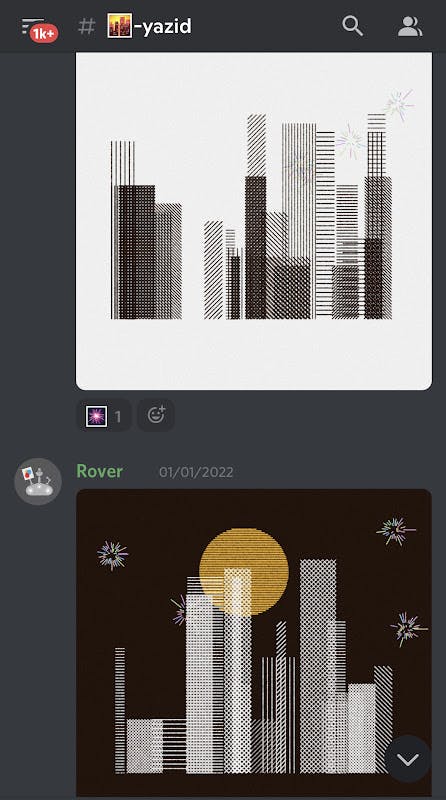What is a city without the people inhabiting it? What are people without a place to call home? Hashed Cities, a landmark collection by generative artist Yazid, elicits such questions for me.
At first glance, like a physical city, the urban landscape is immediately recognizable. No trees. No mountains. All city.
For those familiar with Yazid’s style, it’s also immediately recognizable. With strict adherence to straight lines, these cities are built and unified by a distinctly minimalistic aesthetic one can trace back to City Painting, a plotted piece by early computer artist Grace C. Hertlein.

City Painting, c. 1970s by Grace C. Hertlein
Yazid’s list of influences and references runs deep. Amongst those on full display in Hashed Cities are the Dutch abstract colors favored by Piet Mondrian, Sol LeWitt’s American minimal approach, formative generative art by Vera Molnar, and Brunei’s rich traditional textile history.
Like the diversity of his influences, cities worldwide reflect differences yet retain certain fundamentals around geometry, organization, and purpose. The 363 distinct iterations in the Hashed Cities collection express those differences via unique arrangements of primary colors, black, and white – and in the randomly determined skylines indigenous to each output. These palettes by Yazid often seem to recall real city moments:

New York City covered in snow in Hashed Cities #135

Tokyo at night in Hashed Cities #292

Sydney surrounded by ocean in Hashed Cities #79

Los Angeles at sunset in Hashed Cities #281
From the minimal outputs reminiscent of the spacious city Nuuk, Greenland, to the layered density of outputs echoing the Philippine capital Manila, Yazid’s collection accomplishes a global representation of cityscapes through sheer simplicity.

A sparce Nuuk perhaps in Hashed Cities #311

Shades of Manila in snow in Hashed Cities #96
However, the dynamic and participatory beauty of generative art means that this collection, like cities, would not exist without the people bringing it to life. Consider that each city was generated in real-time as collectors minted them on the fxhash platform. Thus, the buildings in Hashed Cities represent a unique collaboration between artist, medium, and collectors that couldn’t exist without the collective whole.
Without ciphrd’s fxhash platform, there would be no land to build upon. Lacking Yazid’s artistic vision, there would be no materials to build with. And absent the collector’s participation, there would be no labor to assemble the cities. Thus, spacious land, exquisitely designed materials, and passionate labor masterfully weave life from code.
Remarkably, Yazid has played the role of architect and awe-inspirer in both code and community despite living in a city without physical skyscrapers. A resident of Brunei, a tiny country on the island of Borneo, Yazid embodies the possibilities of blockchain-based art.
For instance, each collector is forever recorded on the blockchain and connected to their hashed city, as in a historical census. As such, Hashed Cities show us an entirely novel way of imagining the symbiotic relationship between cities and people. And like people, cities live, breathe, and change.
In a coded gesture that truly sets Yazid’s Hashed Cities apart from the canon of generative art, each iteration subtly transforms over 24 hours. Celestial bodies appear amidst the skyscrapers as Yazid’s code continually coordinates and re-renders their rise and fall with the viewer’s local timezone.

Hashed Cities #135 and #281 with celestial body
While the daily consistency of city and sun is to be expected, something unexpected happened on New Year’s Eve as the world entered 2022. Fireworks. Like kids seeing colorful explosions of light for the first time, collectors lit up Discord and Twitter with screenshots of cities revealing Yazid’s hidden surprise.



These timed surprises are not unlike the work of Banksy — an artist that Yazid admires. Like Girl With Balloon, an artwork that destroyed itself to become another piece entitled Love is in the Bin, Yazid’s Hashed Cities were embedded with a surprise set to trigger at a significant moment.

Love is in the Bin by Banksy
However, there is another unexpected parallel to this iconic Banksy work. Both Banksy’s shredder and Yazid’s code malfunctioned, creating something entirely unforeseen and perhaps even more valuable in the eyes of collectors.
While Girl In Balloon never made it through the shredder as planned, Hashed Cities never achieved the intended outcome of fireworks triggering on each iteration's city date. Instead, in addition to New Year’s Eve, each city begins the day with a 1 in 365 chance of displaying fireworks.
Though the city date attached to each Hashed City doesn’t trigger fireworks, it does trigger feelings and memories for some collectors who have sought out dates with significant meaning.
In fact, after minting, I sought out January 8th, my wife’s birthday. The output was perfect — it has two skyscrapers standing tall together.

Hashed Cities #310
All the while, I’m reminded with each city viewing that we’re part of a more significant network of connectivity than is easily conceivable. This brings me to the thankfulness I feel for the land, materials, and labor joined in each city — in short, the connections making life possible.